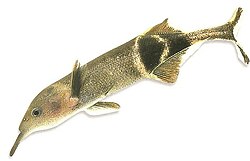Electric fish

An electric fish is a fish that can make electric fields.[1][2] Many fish (sharks, rays, and catfish) can detect electric fields: they are 'electroreceptive'. They cannot make electric fields, and are not called electric fish.
Strongly and weakly electric fish
Electric fish have a special organ that makes electricity. This organ is called an electric organ. It is usually near the tail of the fish. It is made from specialised muscle or nerve cells. When the organ releases electricity this is called an electric organ discharge (or EOD for short).[3]
Based on the strength of the EOD, the electrogenic fish are two types:
- Strongly electric fish: Their discharge is so strong they can stun (and capture) prey with it. Examples of such fish are the electric eel (which is a knifefish, not a true eel), electric catfishes, or electric rays
- Weakly electric fish: Their discharge is not strong enough to stun prey with it; rather, they use the electricity to locate objects, to navigate, or to communicate with other electric fish. Examples of weakly electric fish are Peters' elephantnose fish or the black ghost knifefish.
In total, there are 348 known species of electric fish, in about 56 genera. The only known species that lives in salt water are the electric rays, with 23 species.
Electric Fish Media
Among the electric fishes are electric eels, knifefish capable of generating an electric field, both at low voltage for electrolocation and at high voltage to stun their prey.
The elephantnose fish is a weakly electric fish which generates an electric field with its electric organ, detects small variations in the field with its electroreceptors, and processes the detected signals in the brain to locate nearby objects.
Related pages
- The duck-billed platypus also detects movement by an electric field.
References
- ↑ Albert J.S. & Crampton W.G.R. 2006. Electroreception and electrogenesis. pp. 431–472. In: Evans, David H. & Claiborne, James B. (eds) 2006. The Physiology of Fishes. 3rd ed, CRC Press. ISBN 978-0-8493-2022-4
- ↑ Fishes that can make electricity are electrogenic; those that can detect electric fields are called electroreceptive.
- ↑ Alves-Gomes J. 2001. The evolution of electroreception and bioelectrogenesis in teleost fish: a phylogenietic perspective. Journal of Fish Biology. 58 (6): 1489–1511. [1]





